Armenia – Yerevan, Ararat, Kotayk, Aragatsotn, Armavir November 30-December 1, 3-4, 2019
Day 2
YEREVAN (pop 1,073,000)
Yerevan is the capital and largest city of Armenia as well as one of the world’s oldest continuously inhabited cities. Situated along the Hrazdan River, it is the administrative, cultural, and industrial center of the country. It has been the capital since 1918, the fourteenth in the history of Armenia and the seventh located in or around the Ararat plain.
The history of Yerevan dates back to the 8th century BC, with the founding of the fortress of Erebuni in 782 BC by king Argishti I at the western extreme of the Ararat plain. Erebuni was “designed as a great administrative and religious centre, a fully royal capital.” By the late ancient Armenian Kingdom, new capital cities were established and Yerevan declined in importance. After World War I, Yerevan became the capital of the First Republic of Armenia as thousands of survivors of the Armenian Genocide in the Ottoman Empire arrived in the area. The city expanded rapidly during the 20th century as Armenia became part of the Soviet Union. In a few decades, Yerevan was transformed from a provincial town within the Russian Empire to Armenia’s principal cultural, artistic, and industrial centre, as well as becoming the seat of national government.
Levon’s Divine Underground (Wonder museum in the village of Arninj). About 6kms east of Yerevan in the village of Arninj, don’t miss this “underground city” carved using only a hammer and chisel dover 23 years by one man, Levon Arakelyan, under his house. It all began when he started to dig a pit for potatoes in his cellar in 1985 at the age of 44. Encountering rock, he built stairs to what was supposed to be a wine cellar and then simply continued with many corridors, more stairs (a total of 80 steps), 7 rooms of different sizes, religious altars, designs in the walls, niches for lights and arches – going 21m deep and all superbly carved with lovely high arched tunnels. 400-500 trucks of material were eventually removed. His love affair only stopped on his sudden death from a heart attack in 2009.
Enter his modest house to meet his wife and daughter who gives you a tour. After, in the small living room, see displays of his clothes, hard hats, boots, worn out chisels and hammers and get an opportunity to buy baked goods and honey. The lovely garden has a wall of painted rocks and mosaic pictures of him and his wife. 2000 AMD

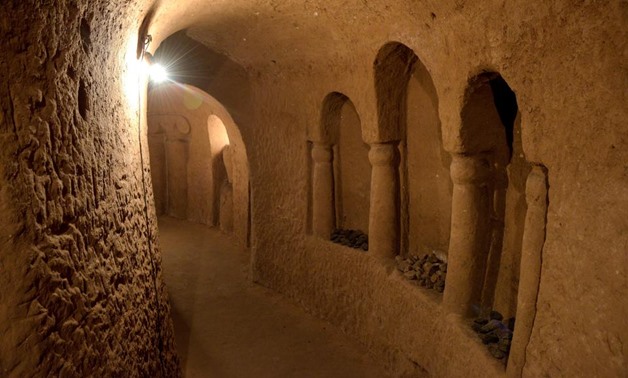
YEREVAN CARD. Offers free admission to 40 museums, 6 tours, and public transportation (including airport transfers) and discounts on shopping, night life, art galleries and some adventure activities. 24-hours – 14,000 AMD; 48-hours – 18,000 AMD; 72-hours – 21,000 AMD. I didn’t buy it as I only use the museums and didn’t think it would be worth it. Available at 2 Abovyon Street, the airport or have it delivered to your hotel free in 20 minutes. www.yerevancard.com. Comes with a map
Yerevan Botanical Garden. Basically put to sleep for the winter, walk up an avenue with round flowerbeds and the rose garden, refurbished by the Government of Switzerland. A once nice, large, round greenhouse is now derelict. Most of the gardens would be mature trees and bush in season. Operated by the National Academy of Sciences. 300 AMD
Folk Art Museum. Wonderful displays of wood carving, metal work, embroidery, lace and rugs, most produced in Armenian villages. 1000 AMD
Mother Armenia. This is a female personification of Armenia. Her most public visual rendering is a monumental hammered copper statue in Victory Park overlooking the capital city.
The current statue replaces a monumental statue of General Secretary Joseph Stalin that was created as a victory memorial for World War II unveiled in 1950. The basalt pedestal is designed to resemble a three-nave basilica Armenian church. In spring 1962, the statue of Stalin was removed, with one soldier being killed and many injured during the process, and replaced by the Mother Armenia statue. “Mother Armenia” has a height of 22 metres (72 ft), with an overall height of 51 metres (167 ft).
The Mother Armenia statue symbolises peace through strength reminding you of some of the prominent female figures in Armenian history, such as Sose Mayrig and others, who took up arms to help their husbands in their clashes with Turkish troops and Kurdish irregulars. It also recalls the important status and value attributed to the older female members of an Armenian family. Its location on a hill overlooking Yerevan makes it look like a guardian of the Armenian capital.
Every year on 9 May, thousands of Armenians visit the statue of Mother Armenia and lay flowers to commemorate the Armenian martyrs of the Second World War. The pedestal hosts the Mother Armenia Military Museum of the Ministry of Defense, a large proportion of the exhibition space is devoted to the Nagorno-Karabakh War of 1988–1994. 
Matendaran – Museum of Ancient Manuscripts. This is a museum, repository of manuscripts, and a research institute, the world’s largest repository of Armenian manuscripts. It was established in 1959 on the basis of the nationalized collection of the Armenian Church, formerly held at Etchmiadzin. Its collection has gradually risen since its establishment, mostly from individual donations. One of the most prominent landmarks of Yerevan, it is named after Mesrop Mashtots, the inventor of the Armenian alphabet, whose statue stands in front of the building.
This is not very interesting to the foreign tourist, but the building is nice. 250 AMD
The Armenian National Academic Theatre of Opera and Ballet. In the NM “Modern Architecture Building” series, It opened in 1953 and consists of two concert halls: the Aram Khatchaturian concert hall with 1,400 seats and the Alexander Spendiaryan Opera and Ballet National Theatre with 1,200 seats. Since it was opened, the company has performed more than 200 different operas and ballets by Armenian, Russian and Western European composers and has performed in more than 20 countries, e.g. in Russia, Spain, Lebanon, United States, Greece, Germany. 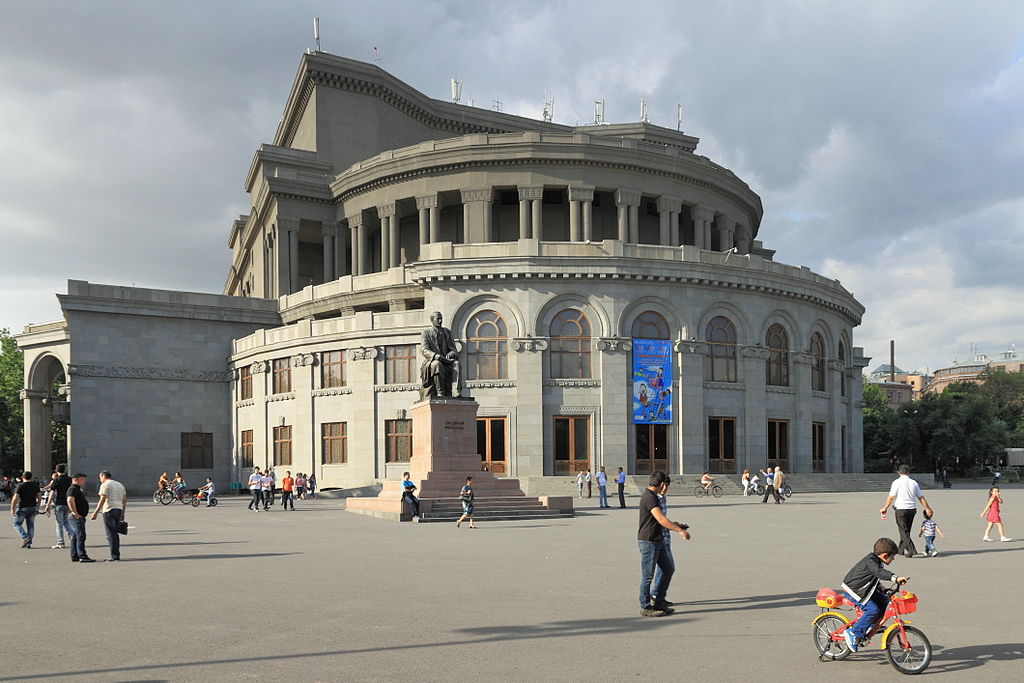 The Woman from Karabakh Statue. Of the many statues in Yerevan, this is only one of a woman, “Armenuhi” which is a collective image of the Armenian woman, not commissioned by the state but rather retrieved from the artist’s studio by her granddaughter in 2009.
The Woman from Karabakh Statue. Of the many statues in Yerevan, this is only one of a woman, “Armenuhi” which is a collective image of the Armenian woman, not commissioned by the state but rather retrieved from the artist’s studio by her granddaughter in 2009.
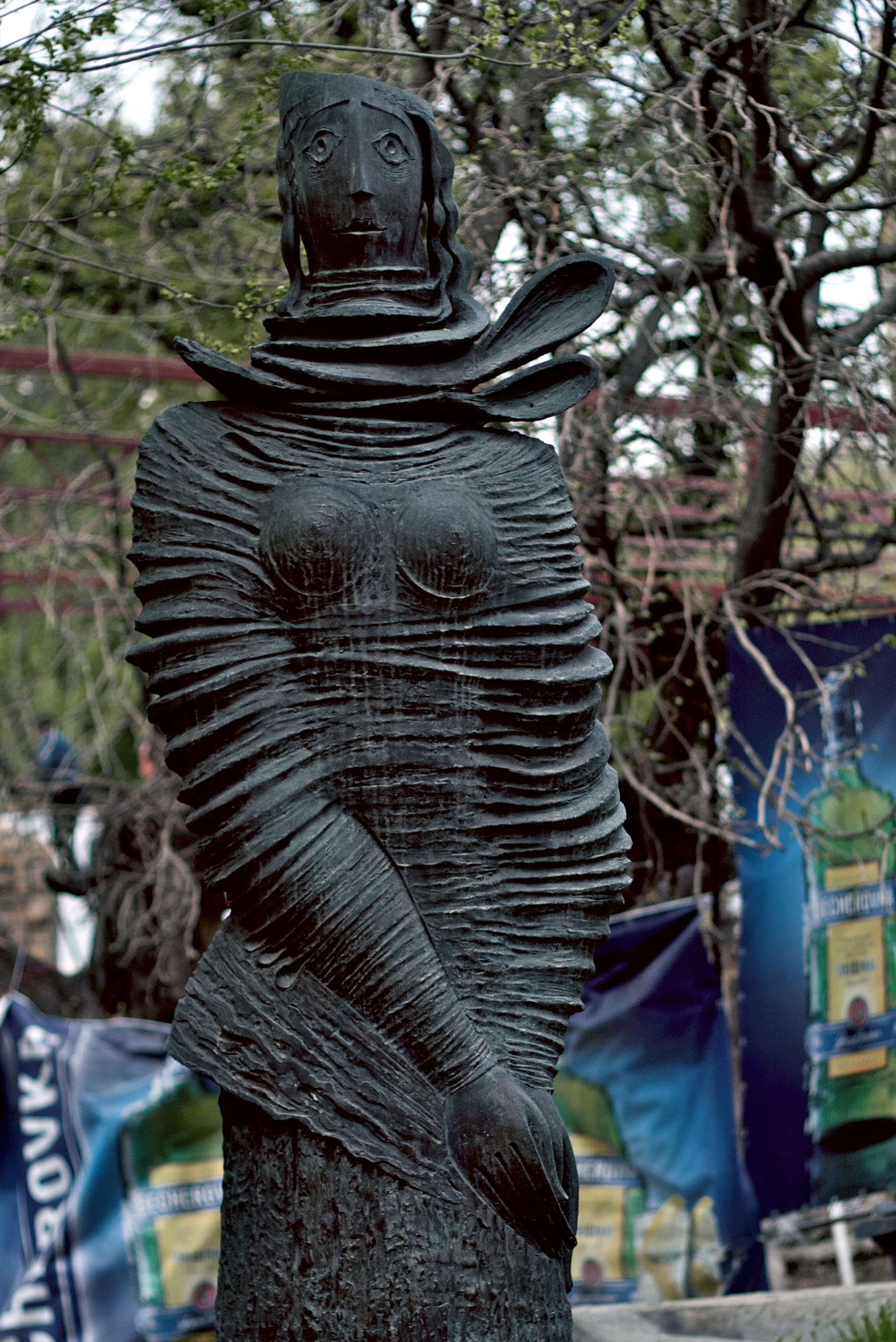
History Museum of Armenia. The 3rd floor has wonderful exhibits from pre-20th century Armenia – the highlights are: the world’s oldest shoe from 3500 BC, two 14th century BC 4-wheel wood carts, lovely 13th-9th century BC pottery, tiny bronzes and many cuneiform inscribed stones. But the descriptions are too wordy. The 2nd floor with more modern history and ethnography is not great. 2000 AMD
National Gallery of Armenia. Over 7 floors of European and Armenian art, not much of which I enjoyed. In the same building as the History Museum. 1500 AMD
Charents Museum of Literature and the Arts. Yeghishe Charents (1897-1937) was an Armenian poet, writer and public activist. Charents’ literary subject matter ranged from his experiences in the First World War, socialist revolution, and frequently Armenia and Armenians. He is recognized as “the main poet of the 20th century” in Armenia.
An early supporter of communism, Charents joined the Bolshevik party, but as the Stalinist terror began in the 1930s, he gradually grew disillusioned with Stalinism and excepting a few poems in journals, Charents could publish nothing after 1934. In 1936, when Soviet Armenian leader Aghasi Khanjian was killed, Charents wrote a series of seven sonnets. After Komitas’s death he wrote one of his last great works, “Requiem Æternam in Memory of Komitas” (1936).
He became a morphine addict under the pressure of the campaign against him. A victim of Yezhov’s purges, he was charged for “counterrevolutionary and nationalist activity” and imprisoned during the 1937 Great Purge. He died in prison hospital. It is unknown where his body was buried. All his books were also banned but were released in 1954 after Stalin’s death.
This was his lovely house but there is zero English and not very interesting. Free
Martiros Saryan House Museum. Saryan (1880-1972) was an Armenian painter and the founder of a modern Armenian national school of painting. Born in Russia, he moved to Yerevan in 1901. Over 4 floors of his former house see hundreds of his paintings, mostly Armenian landscapes and portraits, his lovely light filled studio and living space. 500 AM
Charents Museum of Literature and the Arts. Yeghishe Charents (1897-1937) was an Armenian poet, writer and public activist. Charents’ literary subject matter ranged from his experiences in the First World War, socialist revolution, and frequently Armenia and Armenians. He is recognized as “the main poet of the 20th century” in Armenia.
An early supporter of communism, Charents joined the Bolshevik party, but as the Stalinist terror began in the 1930s, he gradually grew disillusioned with Stalinism and excepting a few poems in journals, Charents could publish nothing after 1934. In 1936, when Soviet Armenian leader Aghasi Khanjian was killed, Charents wrote a series of seven sonnets. After Komitas’s death he wrote one of his last great works, “Requiem Æternam in Memory of Komitas” (1936).
He became a morphine addict under the pressure of the campaign against him. A victim of Yezhov’s purges, he was charged for “counterrevolutionary and nationalist activity” and imprisoned during the 1937 Great Purge. He died in prison hospital. It is unknown where his body was buried. All his books were also banned but were released in 1954 after Stalin’s death.
This was his lovely house but there is zero English and not very interesting. Free
Museum of Russian Art. Opened in 1984 with the private collection of Doctor Aram Abrahamian, a renowned physician and art collector. It consists of paintings, drawings, sculpture and decorative arts tracing the development of Russian art and art groups from the end of the 19th to the beginning of the 20th century. 120 artists are displayed based on art groups. The Scenery Hall is nice with scenic designs and costumes for various performances, folk, circus, dramatic, ballet, and opera like a real-life festival. 1000 AMD
Yerevan Cascade. Fronted by a wonderful sculpture park, this is a monumental set of yellow limestone stairs that rises in seven levels up the mountainside. Construction began in 1971-80 during the Soviet era and the second phase began from 2002-2009. The complex was handed over to the American-Armenian magnate and collector Gerard Cafesjian (1925-2013) in the early 2000s during which the complex underwent further renovation. A large museum complex is planned at the zenith but remains stalled and is still in the early stages of construction.
Each level has over-the top extravagant fountains. Free
Cafesjian Center for the Arts. In the Yerevan Cascade, take the 7 escalators in the interior left hand side past modern, futuristic sculpture and furniture. On two of the levels, take elevators down one flight to two lovely museums. All the art is from Gerard Cafesjian’s contemporary art collection.
Khanjyan Gallery holds a triptych of three lovely, huge paintings of the history of the Armenian alphabet, the 451 BC Battle of the Avarvyn Plain against Zorastrian Persians and the history of Armenia in the 20th century. 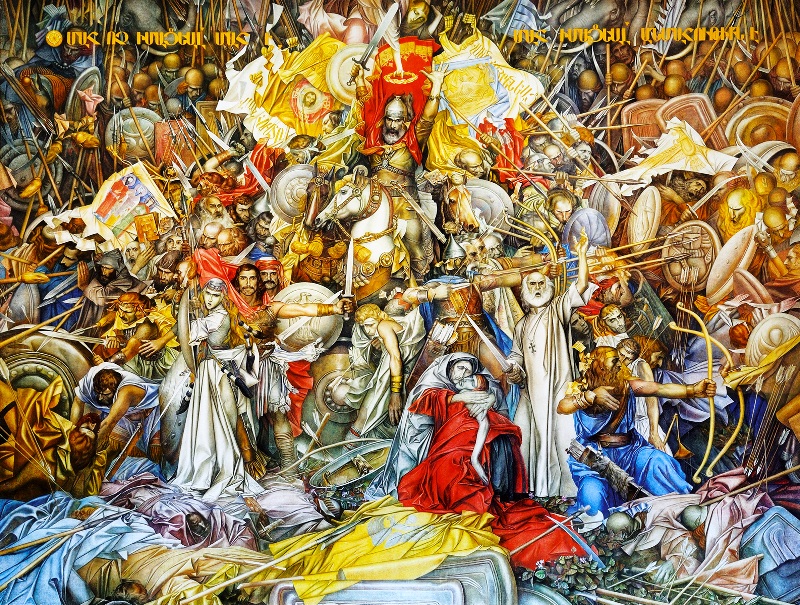
Sasuntsi Davit is a huge stone bas-relief copy 15 times the original painting showing 30 episodes from the famous Armenian epos. 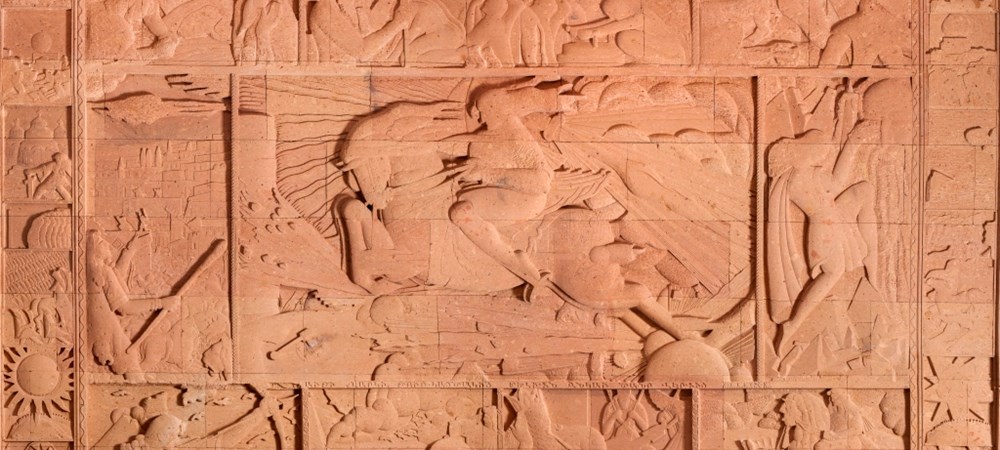
Eagle Gallery has 20th century Armenian graphic art.
At the very top is an exhibit of Swarovski crystal and the auditorium that holds several festivals of folk music, dance, jazz classical and rock/pop (could not be entered). Free
Charles Aznavour Museum. Aznavour (1924-2018) was a French-Armenia singer, lyricist, and diplomat. Aznavour was known for his distinctive tenor voice: clear and ringing in its upper reaches, with gravelly and profound low notes. In a career as a composer, singer and songwriter, spanning over 70 years, he recorded more than approximately 1,200 songs interpreted in 9 languages. Moreover, he wrote or co-wrote more than 1,000 songs for himself and others.
Aznavour was one of France’s most popular and enduring singers. He sold 180 million records during his lifetime and was dubbed France’s Frank Sinatra. He was also arguably the most famous Armenian of his time. In 1998, Aznavour was named Entertainer of the Century by CNN and users of Time Online from around the globe. He was recognized as the century’s outstanding performer, with nearly 18% of the total vote, edging out Elvis Presley and Bob Dylan. Jean Cocteau said: “Before Aznavour, despair was unpopular”.
Aznavour sang for presidents, popes and royalty, as well as at humanitarian events. In response to the 1988 Armenian earthquake, he founded the charitable organization Aznavour for Armenia. In 2009, he was appointed ambassador of Armenia to Switzerland, as well as Armenia’s permanent delegate to the United Nations at Geneva.
He started his last world tour in 2014. On 24 August 2017, Aznavour was awarded the 2,618th star on the Hollywood Walk of Fame. Later that year, he and his sister were awarded the Raoul Wallenberg Award for sheltering Jews during World War II.
This modernistic monumental house is on the left side at the very top of the cascade, but is never open and apparently for sale since he died.
Day 3
Aram Khachaturian House-Museum. (1903-1978) was a Soviet Armenian composer and conductor. He is considered one of the leading Soviet composers.
Born and raised in Tbilisi, Georgia, he moved to Moscow in 1921. His first major work, the Piano Concerto (1936), popularized his name within and outside the Soviet Union. It was followed by the Violin Concerto (1940) and the Cello Concerto (1946). His other significant compositions include the Masquerade Suite (1941), the Anthem of the Armenian SSR (1944), three symphonies (1935, 1943, 1947), and around 25 film scores. Khachaturian is best known for his ballet music—Gayane (1942) and Spartacus (1954). His most popular piece, the “Sabre Dance” from Gayane, has been used extensively in popular culture and has been covered by a number of musicians worldwide. His style is “characterized by colourful harmonies, captivating rhythms, virtuosity, improvisations, and sensuous melodies”.
During most of his career, Khachaturian was approved by the Soviet government and held several high posts in the Union of Soviet Composers from the late 1930s. Considered the most renowned Armenian composer of the 20th century. While following the established musical traditions of Russia, he broadly used Armenian and, to lesser extent, Caucasian, Eastern and Central European, and Middle Eastern peoples’ folk music in his works. He is highly regarded in Armenia, where he is considered a “national treasure”.
The museum is a monumental stone structure fronted by 5 enormous white limestone pillars. 1000 AMD
Dvin Hotel. In the NM “Modern Architecture, Buildings” series, this is three low stories of mirrored glass backed by an 8-story tower with round arched windows. The front center is white marble with a great eagle motif. Sergei Parajanov Museum. (1924-1990) was a Soviet film director and artist of Armenian descent who made significant contributions to Soviet cinematography through Ukrainian, Georgian, and Armenian cinema. He invented his own cinematic style, which was totally out of step with the guiding principles of socialist realism (the only sanctioned art style in the USSR). This, combined with his controversial lifestyle and behaviour, led Soviet authorities to repeatedly persecute and imprison him, and suppress his films.
Sergei Parajanov Museum. (1924-1990) was a Soviet film director and artist of Armenian descent who made significant contributions to Soviet cinematography through Ukrainian, Georgian, and Armenian cinema. He invented his own cinematic style, which was totally out of step with the guiding principles of socialist realism (the only sanctioned art style in the USSR). This, combined with his controversial lifestyle and behaviour, led Soviet authorities to repeatedly persecute and imprison him, and suppress his films.
Although he started professional film-making in 1954, Parajanov later disowned all the films he made before 1965 as “garbage”. After directing Shadows of Forgotten Ancestors (renamed Wild Horses of Fire for most foreign distributions) Parajanov became something of an international celebrity and simultaneously a target of attacks from the system. Nearly all of his film projects and plans from 1965 to 1973 were banned, scrapped or closed by the Soviet film administrations, both local (in Kiev and Yerevan) and federal (Goskino), almost without discussion, until he was finally arrested in late 1973 on charges of rape, homosexuality and bribery. He was imprisoned until 1977, despite a pleas for pardon from various artists. Even after his release (he was arrested for the third and last time in 1982) he was a persona non grata in Soviet cinema. It was not until the mid-1980s, when the political climate started to relax, that he could resume directing.
His health seriously weakened by four years in labor camps and nine months in prison in Tbilisi, Parajanov died of lung cancer in 1990, at a time when, after almost 20 years of suppression, his films were being featured at foreign film festivals. Sergei Parajanov is buried at Komitas Pantheon in Yerevan.
The museum is a gorgeous stone house specially built for him but he died before it was finished and never lived in it, although it has his personal furniture. Don’t miss it as it is full of his wonderful art produced when he was exiled from making films – most unusual collages of broken and found objects. 1000 AMD
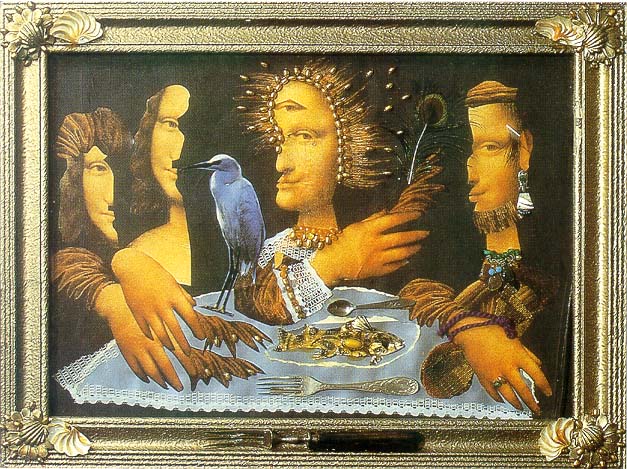
 Modern Art Museum. In a surprisingly nice gallery on the bottom of a decrepit Soviet-style apartment building, I actually liked some of the paintings and sculpture. 500 AMD
Modern Art Museum. In a surprisingly nice gallery on the bottom of a decrepit Soviet-style apartment building, I actually liked some of the paintings and sculpture. 500 AMD
Central (Blue) Mosque. Dating from 1765, it has lovely tile work on the entrance, a large hall and the 22m dome and front of the mosque. It has a 24m high minaret, 26 arcades and a lovely garden in the courtyard. The mosque has a great oval window on the front of the prayer hall.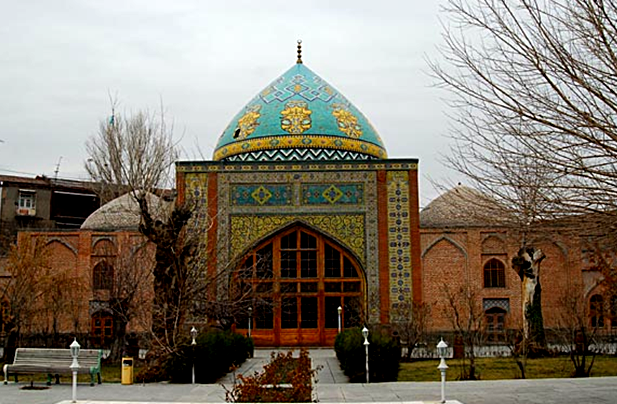
Yervand Kochar Museum. (1899-1979) was a prominent sculptor and modern artist of the twentieth century and a founder of Painting in Space art movement. The Ervand Kochar Museum is located near the Yerevan Cascade and showcases much of his work.
By 1923 Kochar had settled down in Paris, where his art was well received. In 1936, while at the peak of his artistic fame, to the surprise of many, Kochar repatriated to Soviet Armenia. Between 1941 and 1943 Kochar was imprisoned on politically motivated charges, but was eventually freed.
His most recognized works include the statues of David of Sassoun (1959) which has become the symbol of Yerevan; of Vardan Mamikonian (1975); of Komitas (1969) in Echmiadzin. One of his masterpieces in painting is “Disasters of War”. 1000 AMD
Tsitsernakaberd hill / Tsitsernakaberd Memorial Complex. This large complex of monuments built in 1967 has several components to memorialize the 1.5 million Armenians killed in the Armenian Genocide of 1915-22. Pass through 100s of evergreen trees planted by the leaders of several countries and individuals. A wide walk passes the 100m long basalt Memorial Wall with the cities of the Ottoman Empire emptied in the Armenian genocide. The Memorial Pillar is a 44m high, 4-sided obelisk that tapers to a needle point and symbolizes the rebirth of the Armenian people. The Eternal Flame is surrounded by 12 granite steles that lean in towards the flame.
Several khatchars (cross stones) memorialize the Azerbaijan pogroms in Sumgait 1988, Korovabad 1988 and Baku in 1990.
Armenian Genocide Museum. The museum was added to the memorial on the 80th anniversary of the genocide in 1995. In 1882, there were 2,660,000 Armenians in the Ottoman Empire with 1,630,000 in western Armenia. Istanbul alone had 200,000 or 20% of its population Armenian. The attacks on Armenians started in the 1880s and continued until WWI when the Ottoman Empire allied itself with Germany and Austro-Hungary when the real genocide started. It goes into great deal the entire course of the tragedy. Children were one of the main disasters as 165,000 ended up as orphans held in orphanages and Muslim homes in Syria, Lebanon, Iraq, Greece, Georgia and the Ottoman Empire. Free
Tamanyan Architecture Museum. In Soviet times, Tamanian was the city architect of Yerevan. His plan, intended for a city of a couple of hundred thousand residents, has since been mushroomed into a metropolis of over 1 million. Founded in 2001 through the efforts of the grandson of this outstanding architect, the museum exhibits drawings signed by the architect, photographs and other materials donated by the family. The architects bust (by sculptor Artashes Hovsepyan) marks the entrance to the museum. Free
Alexander Spendiaryan House Museum. (1871-1928) was a Russian and Soviet music composer, conductor, founder of Armenian national symphonic music.
Born in modern Ukraine, his artistic abilities were formed in early childhood and when seven he wrote a waltz. His most famous works are the symphonic picture “Three Palms”, the legend “Preacher Beda”and the melody declamation “We’ll Have a Rest”. His symphonic pieces, songs and romances, choral works, and musico-declamatory pieces earned him high marks among audiences and professional musicians.
In 1924, he moved to Yerevan from Russia. The “Yerevan Sketches (Etudes)” (1925) comprise some of the best work of Spendiarov’s last years.
In 1967, the Alexander Spendiarov House Museum was established in the house he lived during the last years of his life and shows his study, personal belongings, numerous documents and other belongings including two violins and a piano.
Vernissage Market. This is a huge (2 blocks long, 3 aisles and 5 rows wide) open air market mostly with jewelry and decorative house ware.
Saint Gregory the Illuminator Cathedral (Yerevan Cathedral) is currently the largest cathedral of the Armenian Apostolic Church in the world and considered to be one of the largest religious buildings in the South Caucasus along with the Holy Trinity Cathedral of Tbilisi. It’s visible from many corners of Yerevan.
The cathedral was constructed between 1997-2001 and consecrated in 2001, the 1700th anniversary of the proclamation of Christianity as the state religion of Armenia. It houses the relics of Saint Gregory the Illuminator and the Holy Remains of St. Gregory that were brought from Naples, Italy. Shortly after the consecration of the cathedral, Pope John Paul II paid a visit to the cathedral.
The huge cathedral is a complex consisting of three churches: the Cathedral (Main Church) with 1700 seats and the Chapels of St. Tiridates the King and of Saint Ashkhen the Queen (both with 150 seats). These two royal figures were the crucial helpers of St. Gregory in converting Armenia to Christianity. The belfry tower (which consists of more than 30 arches) and the court are located at the entrance of the Cathedral. The total area of the complex is around 3,822 square meters, while the height of the cathedral from the ground to the top of the cross is 54 meters.
This new pink granite building is very large with a gigantic curved ceiling topped with a dome supported on 8 large cross ribs. The altar is polished white marble. The only wall decoration are small light sconces. Enter the large narthex with a dome over an old canopy.

Yerevan Dolphinarium. In Komitas Park in central Yerevan, it had 4 dolphins, 2 sea lions and a seal with seating for 900. Open air in the summer, it had a glass dome for the winter months. It opened in 2011 amid many protests from animal rights activists especially as the tank is only 5m deep and 32m in diameter. It closed in 2013.
A dolphinarium in a Best Western Hotel in Dilijian closed in 2018. A dolphinarium was slated to open in Gyumri in 2019.
Erebuni. (Arin Berd – the “Fortress of Blood”), is an Urartian (Kingdom of Van) fortified city built on a 65m tall hill overlooking the Ararat plain and the main roads, one of several fortresses built along the northern Urartian border and was one of the most important political, economic and cultural centers of the vast kingdom. The name Yerevan itself is derived from Erebuni.
Erebuni was founded by Urartian King Argishti I (r. ca. 785–753 BC) in 782 BC. It was built on top of a hill called Arin Berd overlooking the Aras River Valley to serve as a military stronghold to protect the kingdom’s northern borders. Similar to other Urartian cities of the time, it was built on a triangular plan on top of a hill with 10-to-12-metre high ramparts of basalt, tuff, wood and adobe. Behind them, a grand palace, a colonnaded royal assembly hall, a temple dedicated to Khaldi, a citadel were central and inner walls richly decorated with murals and other wall paintings, displaying religious and secular scenes.
Successive Urartian kings made Erebuni their place of residence during their military campaigns against northern invaders and continued construction work to build up the fortress defences. Kings Sarduri II and Rusa I also utilized Erebuni as a staging site for new campaigns of conquest directed towards the north. In the early sixth century the Urartian state, under constant foreign invasion, collapsed.
Despite numerous invasions by successive foreign powers, the city was never truly abandoned and was continually inhabited over the following centuries, eventually branching out to become the city of Yerevan.
Erebuni Museum. At the base of the fortress (now only foundation walls), the interesting artifacts are several rhytons (metal drinking horns with the head of a horse and other animals), lovely polished pots, stone water pipes, 1,500 litre jars for wine and stones with cuneiform writing. 1000 AMD
The archaeological site of the city of Dvin. A tentative WHS (25/08/1995)
GARNI
Garni has been settled from the 4th millennium to the Middle Ages. Several invasions and the earthquake of 1679 spelled the end of its prosperity.
Garni Temple (Temple of Mithra). Built in the 2nd half of the 1st century, it is part of a royal complex that included fortified walls (enter through a gate and part of the wall), a royal palace (now only foundations remain) and the St Scion Church of Garni (next to the temple, round, the base stones have been reconstructed). The temple is of Greek design on a Roman podium – 5.05m x 7.98m surrounded by ionic columns, six on the front and 8 on the sides. The capitals, portal, frieze, gables and ceiling are decorated with date palms, garlands and acanthus leaves. Grape, walnut and pomegranit designs show the influence of local builders. Dedicated to the god of the sun, Mythra, he is shown struggling against a bull on the pedestal of the altar. The temple was initially plundered by the Arabs in the 1st half of the 7th century and then destroyed by the 1679 earthquake. Completely reconstructed in 1968-76, half of the stones of the temple, all the vaulted roof and a third of the columns are of new stone. 1500 AMD Garni Canyon National Park. Holding the River Azat, the easiest views down into the canyon are from the temple or drive out to Geghard Monastery in Goght as the road follows the canyon that terminates in the upper Azat Valley. It has some nice rock walls.
Garni Canyon National Park. Holding the River Azat, the easiest views down into the canyon are from the temple or drive out to Geghard Monastery in Goght as the road follows the canyon that terminates in the upper Azat Valley. It has some nice rock walls.
Geghard Monastery, Goght. A World Heritage Site (Monastery of Geghard and the Upper Azat Valley), it was originally built in the 4th century by Gregory the Illuminator, the acetic monks lived in caves accessed by ladders, and it was known as the Monastery of the Caves. In 920, the Arabs plundered it and it was rebuilt with fortifications. It was sacked by the Mongols in 1127 and then the Timurids and the present building dates from the 1300s. It was a pilgrimage site for the reliquaries of the Holy Lance, the spear used by a Roman soldier to pierce the crucified Christ. It’s current name, Geghard means Monastery of the Spear. There is also a relic of a fragment of Noah’s Ark. Earthquakes in 1679 and 1840 heavily damaged it but it has been completely rebuilt and is now used in the summer by Catholicos.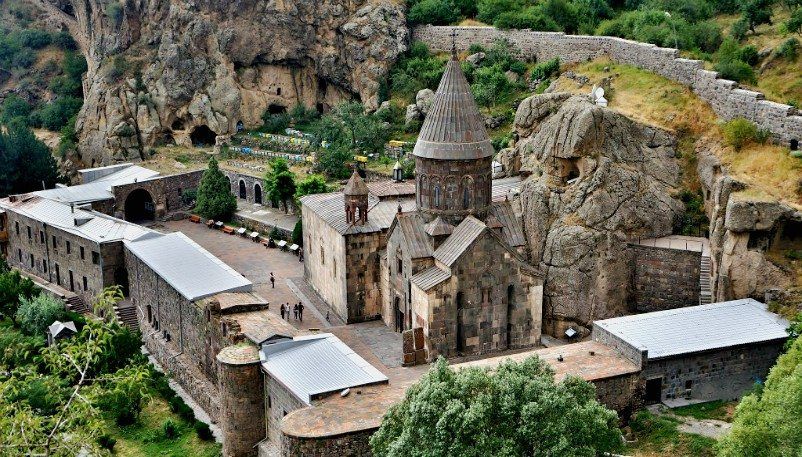

It is 11kms past Garni and the end of the road. I originally hoped that I could continue east on my way to Nagorno but both the canyon and Azhdahak Mountain pose significant physical barriers. I then drove the 50kms back to Yerevan and then to Lake Savan before turning south on to my way to Nagorno.
GO TO Armenia – Gegharkunik, Lori, Shirak, Tavush (Gyumri)
I returned from southern Armenia on December 3.
Artashat. The 12 small hills of Khor Virap at the confluence of the Arax and Metsamor Rivers were chosen as the site of a new Armenian capital Artashat by the founder of the Artashesian Dynasty, Artashes i. The city was built between 189-188 BC and remained the main capital of Greater Armenia for 600 years. The Romans destroyed it in 59 AD, retaken by the Armenians in 63 by T’rdat I (r. 63-88), the founder of the Arshakuni dynasty. He reconstructed Artashat in 66. Rome destroyed it again in 163.
King Khosrov III moved the capital to Dvin in 335. The Persians destroyed Artashat’s fortress walls in 368, it was rebuilt and survived until the fall of the Arshakuni dynasty in 428.
Khor Virap Monastery, Lusarat. Venerated since the time of Gregory the Illuminator’s death in 334 and a pilgrimage site in the 5th-6th centuries. The present monastery dates to the 7th century and sits on hill 6 of the ancient city of Artashat.
St Astvatsatsin Church. The main church in the center of the fortress walls was destroyed by the Timurids in the 14th century and rebuilt in the 17th century. It was damaged in the earthquakes in 1939, 1949, and 1957 and renovated in 2000-01. The outside has a eight faceted conical drum. At the front entrance is 17th century bell tower supported on 8 columns. It is a working church.
St Gevorg Church (Khor Virap). The story begins in the 3rd century when the Armenian King Khosrov the Great was murdered by Anak who was recruited by the Persian Sassanids. Anak was executed but one of his sons (Gregory the Illuminator) escaped.
Khosrov had two sons. T’rdat was taken to Rome, raised under royal patronage and became the head of a Roman legion to attack the Sassanids in Armenia. After driving them out I287, he put Grigor into Khor Virap, a deep pit in the castle dungeon at Artashat, filled with poisonous snakes and insects. There he languished for 13 years. The present king met Grigor at Zvartnots, repented his sins, converted to Christianity, was cured of his madness, thus beginning the conversion of the kingdom of Armenia to Christianity beginning in 301.
It is sitting in the SW corner of the walls with a renovated building on top and can’t be entered.
The Archaeological Site of the city of Dvin (25/08/1995). Dvin was a large commercial city and the capital of early medieval Armenia. It was situated north of the previous ancient capital of Armenia, the city of Artaxata, along the banks of the Metsamor River, 35 km to the south of modern Yerevan. The site of the ancient city is currently not much more than a large hill.
The ancient city of Dvin was built by Khosrov III Kotak in 335 and since the city had been used as the primary residence of the Armenian Kings of the Arsacid dynasty. Dvin boasted a population of about 100,000 citizens, one of the most populous and wealthiest cities east of Constantinople.
After the fall of the Armenian Kingdom in 428, Dvin was controlled by the Sassanids, then captured and pillaged in 640 in the Arab conquest of Armenia. They slaughtered 12,000 of its inhabitants and carried 35,000 into slavery. Dvin became the center of the province of Arminiya, the Arabs called the city Dabil.
Frequent earthquakes and continued warfare led to the decline of the city from the beginning of the 10th century. During a major earthquake in 893, the city was destroyed, along with most of its 70,000 inhabitants.
Although Armenia was a battleground between Arabs and Byzantine forces for the next two centuries, in the 9th century it still flourished. In 1236, the city was completely destroyed by Mongols.
VAGHARSHAPAT
As the main shrine of Armenian Christians worldwide, Etchmiadzin has been an important location in Armenia not only religiously, but also politically and culturally. A major pilgrimage site, it is one of the most visited places in the country.
CATHEDRAL and CHURCHES of ECHMIATSIN and the ARCHAEOLOGICAL SITE of ZVARTNOTS
Echmiatsin Cathedral. This is the mother church of the Armenian Apostolic Church, located in the city of Vagharshapat (Etchmiadzin). According to most scholars it was the first cathedral built in ancient Armenia, and is often considered the oldest cathedral in the world.
The original church was built in the early fourth century—between 301 and 303 according to tradition—by Armenia’s patron saint Gregory the Illuminator, following the adoption of Christianity as a state religion by King Tiridates III. It was built over a pagan temple, symbolizing the conversion from paganism to Christianity. The core of the current building was built in 483/4 by Vahan Mamikonian after the cathedral was severely damaged in a Persian invasion. From its foundation until the second half of the fifth century, Etchmiadzin was the seat of the Catholicos, the supreme head of the Armenian Church.
Although never losing its significance, the cathedral subsequently suffered centuries of virtual neglect. In 1441 it was restored as catholicosate and remains as such to this day. Since then the Mother See of Holy Etchmiadzin has been the administrative headquarters of the Armenian Church. Etchmiadzin was plundered by Shah Abbas I of Persia in 1604, when relics and stones were taken out of the cathedral to New Julfa in an effort to undermine Armenians’ attachment to their land. Since then the cathedral has undergone a number of renovations. Belfries were added in the latter half of the seventeenth century and in 1868 a sacristy was constructed at the cathedral’s east end. Today, it incorporates styles of different periods of Armenian architecture. Diminished during the early Soviet period, Etchmiadzin revived again in the second half of the twentieth century, and under independent Armenia.
As the main shrine of Armenian Christians worldwide, Etchmiadzin has been an important location in Armenia not only religiously, but also politically and culturally. A major pilgrimage site, it is one of the most visited places in the country. Along with several important early medieval churches located nearby, the cathedral was listed as a World Heritage Site by UNESCO in 2000.
This church has a 12-sided drum dome, a bell tower with 8 columns supporting the top dome and a tower on each side. The early frescoes inside the cathedral were restored in the 18th century. Stepanos Lehatsi (Stephen of Poland) illustrated the belfry in 1664. In the 18th and 19th centuries, Armenian painters created frescoes of scenes from the old testament and Armenian saints. The painting of the Mother of God under the altar have survived to this day. The wooden doors of the cathedral were carved in Tiflis in 1889.
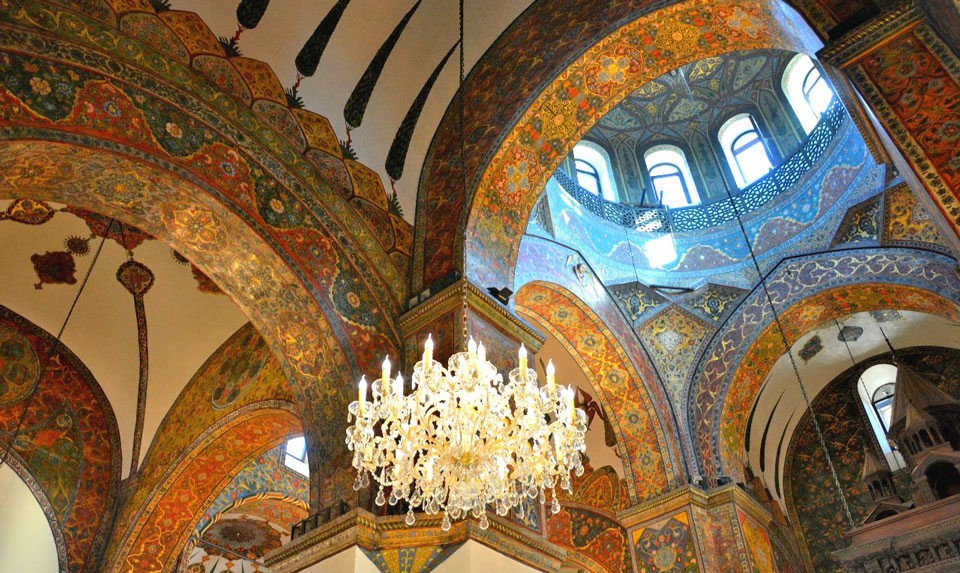 Holy Mother of God. (St Mariam Ashvatsatsin). Built in 1767 originally of wood, then replaced by stone 100 years later. Unusually it has no dome and 3 naves each with a vaulted ceiling of the same height and separated by 3 columns. The altar is 3 part grand brass with icons. The walls are unadorned except with some framed paintings.
Holy Mother of God. (St Mariam Ashvatsatsin). Built in 1767 originally of wood, then replaced by stone 100 years later. Unusually it has no dome and 3 naves each with a vaulted ceiling of the same height and separated by 3 columns. The altar is 3 part grand brass with icons. The walls are unadorned except with some framed paintings.
The church was renovated in 1986 when the bell tower with 12 columns was added.
Church of the Angels. A new 16-sided church supporting a dome that covers the entire church. The only windows are the 32 windows at the base of the dome. The altar is backed by several crosses in many styles and flanked by two columns topped by a double headed snake and dragon topped by crosses. It is lovely.
Enter the area through a large stone arch. It is fronted by a huge 15m high wall with 5 open arches each filled with 3 ancient cross stones.
ASHTARAK
Saint Gevork Monastery. The Monastery of Mughir dating from the 1280s was the resting place of St Gevorg and there was an eternal flame that only men named Gevorg could pay their respects and add oil. A church built in 1632-35, demolished and rebuilt in 1670 – the present building. Unusually there are windows in all four sides. An umbrella dome has 5 belts of red stone and above the windows are carvings of the gospels. There are many cross stones, the oldest from 932. The altar is richly painted and there are some murals on the left side. It is a common site of pilgrimage. 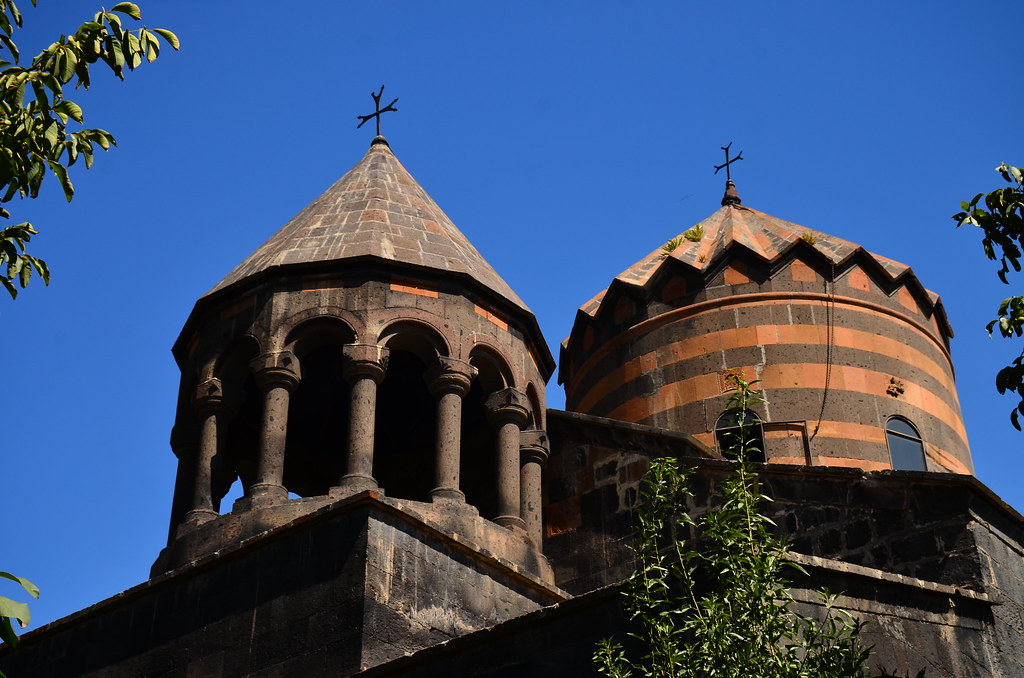 Hovhannavank Monastery (Saint Sargis Monastery), Ohanavan. The façade is richly decorated with red crosses, geometric carvings, a central column and wood door. The gavit is huge with a 5-bell tower supported by 12 columns above and 3 huge columns below. There are several large cross stones. The church also has a large dome with red stone cross rib vaulting. A chapel is separate on the left side. There is a wall in front but no out buildings nor information signs.
Hovhannavank Monastery (Saint Sargis Monastery), Ohanavan. The façade is richly decorated with red crosses, geometric carvings, a central column and wood door. The gavit is huge with a 5-bell tower supported by 12 columns above and 3 huge columns below. There are several large cross stones. The church also has a large dome with red stone cross rib vaulting. A chapel is separate on the left side. There is a wall in front but no out buildings nor information signs. 
Artashavan Holy Cross, Artashavan. In the NM “Religious Monuments” series, this unusual cross must be seen close up to appreciate its complex structure. The internal frame of 8 metal tubes has welded to them hundreds of crosses made of metal tubes and of all sizes. Below is a new orange stone chapel. It is on a hill about 1.2kms north of the village limits.

From here I continued to the north of Armenia driving around the Azhdahak volcano to Spitak.
GO TO Armenia – North
NOMAD MANIA Armenia – Yerevan, Ararat, Kotayk, Aragatsotn, Armavir
World Heritage Sites
Cathedral and Churches of Echmiatsin and the Archaeological Site of Zvartnots
Monastery of Geghard and the Upper Azat Valley
Tentative WHS
The archaeological site of the city of Dvin (25/08/1995)
The basilica and archaeological site of Yererouk (25/08/1995)
Roads, Road Bridges and Tunnels: U1 (Yerevan-Bavra)
Religious Temples: Lusarat: Khor Virap Monastery (Sight)
World of Nature
Kotayk: Azhdahak volcano
Park: Khosrov Forest
Festivals
Golden Apricot Yerevan International Film Festival
High Fest International Performing Arts Festival
Ski Resorts
Tsakhkadzor Ski Resort
Religious Monuments: Artashavan: Artashavan Holy Cross
The Dark Side: Araks: Sardarapat Monument
Cities of Asia and Oceania
YEREVAN World Capital World City and Popular Town
Airports: Yerevan (EVN)
Railway, Metro, Funiculars, Cable Cars: Yerevan Metro
Museums
Cafesjian Center for the Arts
Charents Museum of Literature and the Arts (Yeghishe Charents House and Musuem)
Charles Aznavour Museum
Erebuni Museum
Folk Art Museum
History Museum of Armenia
Matendaran – Museum of Ancient Manuscripts
Modern Art Museum
Museum of Russian Art
National Gallery of Armenia
Sergei Parajanov Museum
Tamanyan Architecture Museum
Yervand Kochar Museum
House Museums/Plantations
Alexander Spendiaryan House Museum
Aram Khachaturian House-Museum
Martiros Saryan House Museum
Religious Temples: Saint Gregory the Illuminator Cathedral
Modern Architecture Buildings:
Hotel Dvin
The Armenian National Academic Theatre of Opera and Ballet
World of Nature: Garni Canyon
Entertainment/Things to do
Yerevan Cascade
Yerevan Dolphinarium (closed in 2013)
Zoos: Yerevan Zoo
Botanical Gardens: Yerevan Botanical Garden
Markets
Vernissage
Gum Market
Caves: Master Levon’s Divine Underground (Sight)
Monuments
Mother Armenia
The Woman from Karabakh Statue
The Dark Side
Armenian Genocide Museum
Tsitsernakaberd hill / Tsitsernakaberd Memorial Complex (Sight)
Villages and Small Towns
ASHTARAK
Religious Temples:
Saint Gevork Monastery
Ohanavan: Hovhannavank Monastery (Saint Sargis Monastery)
VAGHARSHAPAT*
World Heritage Sites: Cathedral and Churches of Echmiatsin and the Archaeological Site of Zvartnots
Museums
Historical and Ethnographic Museum of Echmiadzin
Zvartnots Historical-Cultural Museum-Reserve
Religious Temples
Echmiatsin Cathedral
Holy Mother of God
GARNI*
World Heritage Sites: Monastery of Geghard and the Upper Azat Valley
Religious Temples:
Garni Temple
Goght: Geghard Monastery
Castles, Palaces, Forts: Kakavaberd